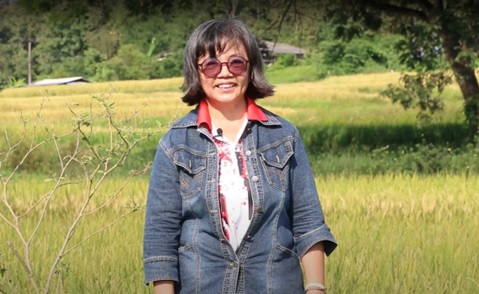Glutinous rice is widely grown in the north and northeast of Thailand as a main staple food. It is therefore considered culturally vital to the life of people in the north and northeast. Despite its significant economic and social impact, glutinous rice farmers are faced with low earnings due to production loss and market instability. To ease the pain of glutinous rice growers, BCG-NAGA Belt Road project was initiated to introduce proper technologies and innovations to help farmers reduce production cost, improve productivity, and cut greenhouse gas emissions. One of the promising, yet simple technology is the incorporation of azolla in rice cultivation.

Dr. Kanyarat Sirithunya, BCG-NAGA Belt Road project coordinator, explained that the BCG-NAGA Belt Road is a project initiated under the Bio-Circular-Green Economy (BCG) agenda with an objective to utilize modern agriculture technology to improve income and uplift the livelihood of glutinous rice farmers in the Mekong basin. Spearheaded by NSTDA in partnership with the public and private entities, the project has been piloted in four provinces – Lampang, Chiang Rai, Udon Thani and Nakhon Phanom, introducing technologies and best practices in rice production and processing, such as production of high-quality rice seed, to increase production efficiency and reduce production cost.
“Soaring fertilizer costs are among main problems faced by our rice farmers. Azolla represents a perfect alternative biofertilizer for rice cultivation due to its ability to add nitrogen to rice paddies. Furthermore, it can suppress weed growth in rice fields and can be used as animal feeds,” Dr. Kanyanat added.

Azolla is a floating freshwater fern found in warm temperate and tropical regions. It forms a symbiotic relationship with a nitrogen-fixing cyanobacterium present in its leaf cavity, explaining azolla’s high N content of 3-5% while other crops only contain 1-2% N and thus making it effective as a nitrogen biofertilizer.

Dr. Suraphon Chaiwongsar of Rajamangala University of Technology Lanna, Lampang and a working group member of BCG-NAGA Belt Road revealed another benefit of azolla. Azolla has been found to facilitate heat dissipation in rice fields, resulting in the decrease of water temperature in rice paddies by 3°C. Lowering temperature helps reduce both plant stress and greenhouse gas emissions.
The use of azolla in rice production has been implemented in over 24,000-rai rice fields, approximately 3,840 ha, in four provinces, resulting in a total production of 24,000 metric tons azolla worth around THB 845 million. The practice also reduces greenhouse gas emissions by 400 tons CO2, or around THB 400,000 in carbon credit.
“Studies have revealed that azolla can replace nitrogen fertilizer by half, while maintaining the same level of rice productivity. Azolla, therefore, represents a solution to soaring fertilizer prices and supports an organic farming practice that improves farmers’ income and reduce negative impacts on the environment.”
